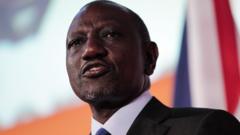Since taking office, President William Ruto has witnessed an overwhelming surge of public dissatisfaction, described as unparalleled in Kenya's history. Initially welcomed with enthusiasm, Ruto now confronts a unified front of discontent that transcends ethnic, religious, and class boundaries. The frustration has escalated to rallies, slogans like "Ruto must go," and even violence, leading to a staggering loss of life, with at least 10 deaths reported in the past year alone.
The president has publicly questioned why past leaders, such as Daniel arap Moi, who ruled with severe oppression, didn't face the same level of contempt, hinting at the unprecedented nature of the current backlash. Political analysts highlight that the public's discontent is not strictly tied to ethnic lines, as protests have emerged from diverse communities unhappy with Ruto's governance.
Ruto's image as a champion for the common citizen, shaped by his rise from humble beginnings, has sharply contrasted with the reality of disillusionment as Kenyans grapple with soaring living costs, aggressive taxation, and corruption. Social media plays a significant role in this discontent, amplifying voices that express collective anger aimed at the president, which could pose a threat to his leadership.
Experts assert that while such backlash against a sitting president isn't a new occurrence, the scale and fervor of Ruto's predicament signify a significant shift in political dynamics. The digital-savvy youth are chiefly driving the wave of criticism, promoting narratives that reject past ethnic divisions in favor of national unity.
Despite this negativity, Ruto has publicized several government initiatives like affordable housing and healthcare aimed at improving the lives of Kenyans. However, rising taxes associated with these programs have only intensified calls for economic justice and accountability. Observers note that the administration’s tone remains unchanged even amid this discontent, leading to a growing perception of disconnect between the government and the populace.
While Ruto aims to quell dissent through promises of stability and peace, the outcry for fundamental changes in governance keeps increasing, challenging the very foundation of his presidency. As the protests show no signs of abating, deeper issues of economic hardship and political representation loom large, indicating a turning point in Kenya's socio-political landscape.





















